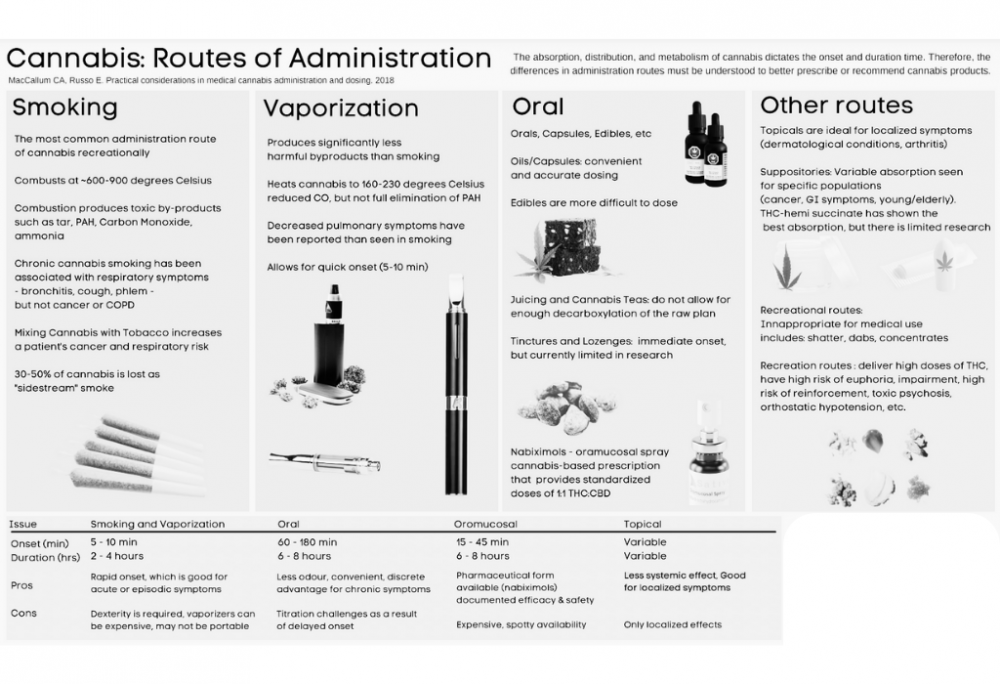
Overview of Cannabis Routes of Administration and Organ-Specific Impact
Introduction
The delivery of cannabis-based therapies can be customized to target specific organs or bodily systems. This comprehensive overview synthesizes current scientific literature to shed light on the most effective routes of administration for different organs.
Central Nervous System: Head and Brain
Inhalation (smoking or vaping) offers a rapid delivery of cannabinoids like THC and CBD across the blood-brain barrier, providing quick relief in neurological conditions such as epilepsy or anxiety1. Sublingual tinctures can also be effective for quicker onset without the risks associated with inhalation2.
Musculoskeletal System: Neck and Shoulders, Arms, Wrists, Fingers, Legs, Feet, and Joints
Localized topical ointments, balms, or patches containing cannabinoids can provide targeted relief for muscle tension or discomfort3.
Respiratory System: Chest and Lungs
While inhalation directly targets the lungs, individuals with respiratory issues should seek alternative administration routes such as oral ingestion or sublingual application4.
Digestive System: Torso, Stomach, Intestines, and Liver
Oral ingestion via edibles or capsules allows cannabinoids to be metabolized by the liver, providing more extended relief and targeting gastrointestinal conditions5.
Reproductive System: Genitals
For localized conditions like endometriosis or testicular inflammation, topical applications might offer targeted relief although research is limited in this area6.
Cardiovascular System: Blood Vessels and Heart
Sublingual administration or inhalation can provide rapid systemic effects but may pose risks for those with heart conditions7.
Other Organs: Kidneys and Pancreas
The literature is scant on organ-specific administration for these organs. Typically, systemic administration like oral or inhalation are the routes used when kidney or pancreatic conditions are being targeted.
Precautionary Note
Patients with the following conditions should exercise caution and consult with Dr. Caplan at CED Clinic for more specialized, evidence-based guidance:
- Cardiovascular Diseases
- Respiratory Ailments
- Liver Disorders
- Neurological Conditions
- Pregnancy and Reproductive Health Issues
Footnotes
- Devinsky, O., et al. (2017). Cannabidiol in patients with treatment-resistant epilepsy: an open-label interventional trial. The Lancet Neurology, 15(3), 270-278.
- Bruni, N., et al. (2018). Cannabinoid Delivery Systems for Pain and Inflammation Treatment. Molecules, 23(10), 2478.
- Maida V, et al. (2017). The Use of Cannabis for Headache Disorders. Cannabis Cannabinoid Res. 2(1), 61–71.
- Tashkin, D. P. (2018). Effects of Marijuana Smoking on the Lung. Annals of the American Thoracic Society, 10(3), 239-247.
- Russo, E. B. (2016). Cannabinoids in the management of difficult to treat pain. Therapeutics and Clinical Risk Management, 4, 245-259.
- Russo, E. B. (2011). Taming THC: potential cannabis synergy and phytocannabinoid-terpenoid entourage effects. Br J Pharmacol, 163(7), 1344-1364.
- Stanley, C., et al. (2013). Is the cardiovascular system a therapeutic target for cannabidiol?. British Journal of Clinical Pharmacology, 75(2), 313-322.
📗 Note: If the diagram is your first sip of wine, the book is the entire vineyard. Savor it here 📗



